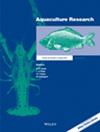加勒比海河口蛤Polymesoda arctata (Deshayes, 1854)在实验室中暴露于不同环境条件下的能量生理
IF 1.9
4区 农林科学
Q2 FISHERIES
引用次数: 0
摘要
河口蛤(Polymesoda arctata)是加勒比地区重要的商业双壳类之一,目前被认为因过度开发和栖息地丧失而濒临灭绝。为了了解其养殖和再放养的环境要求,在实验室条件下对其能量生理性能进行了评估,以响应其自然栖息地食物浓度和水质的变化。不同的生理变量,包括过滤率(FR),假粪便产生率(RR),摄入(IR),吸收(AR),耗氧量(OCR),铵排泄(UR),以及吸收效率(AE)和生长范围(SFG),在五个连续的实验中,不同浓度的食物或颗粒有机物质(1.8,4.0,7.3和13.0 mg L−1相当于2.3,5.0,9.3和16.6 mg微藻Isochrysis galbana L−1),测试了盐度(5、15和25‰)、温度(27、29和32℃)、氨浓度(7、48和77µg NH3-N L−1)和溶解氧饱和度(24、48和93%)。在食物浓度、盐度和温度的中间条件下,除了低盐度下的OCR和UR值较高,以及低温下的AE、AR和SFG值较高外,大多数生理变量的测量值都较高。在低氨浓度和高溶解氧饱和度的条件下,大多数生理变量增加。尽管该物种在不同生境环境变化下表现出生理可塑性、耐受性和足够的生长繁殖能量,但对环境也表现出较高的敏感性,在颗粒有机物(7.2 mg L−1或9.3 mg galbana L−1)、盐度(15‰)、温度(27 ~ 29℃)、低氨浓度(7 μg NH3-N L−1)和高溶解氧饱和度(93%)的中间条件下,SFG值最高。根据我们的研究结果,我们建议将该值用于实验室的亲鱼和幼鱼养殖的生殖调节,并作为选择养殖区域和补充试验的输入。本文章由计算机程序翻译,如有差异,请以英文原文为准。
Energetic Physiology of the Caribbean Estuarine Clam Polymesoda arctata (Deshayes, 1854) Exposed to Different Environmental Conditions under Laboratory
The estuarine clam Polymesoda arctata is one of the commercially important bivalves of the Caribbean, which is currently considered endangered by overexploitation and habitat loss. With the purpose of gain knowledge about its environmental requirements for aquaculture and restocking purposes, its energetic physiology performance was evaluated under laboratory conditions in response to the variation of food concentration and water quality registered in their natural habitat. Different physiological variables, including the rates of filtration (FR), pseudofeces production (RR), ingestion (IR), absorption (AR), oxygen consumption (OCR), and ammonium excretion (UR), as well as absorption efficiency (AE) and scope for growth (SFG), were estimated in five successive experiments, where different concentration levels of food or particulate organic matter (1.8, 4.0, 7.3, and 13.0 mg L−1 equivalent to 2.3, 5.0, 9.3, and 16.6 mg of the microalgae Isochrysis galbana L−1), salinity (5, 15, and 25‰), temperature (27, 29, and 32°C), ammonia concentration (7, 48 and 77 µg NH3-N L−1), and dissolved oxygen saturation (24, 48, and 93%) were tested. Intermediate conditions of food concentration, salinity, and temperature resulted in higher values for most of the physiological variables measured, except for the higher values of OCR and UR obtained at low salinity, as well as the higher values of AE, AR, and SFG measured at low temperatures. Most of the physiological variables increased under conditions of lower ammonia concentrations and higher dissolved oxygen saturation in the water. Although this species exhibited physiological plasticity, tolerance, and enough energy for growth and reproduction under the environmental variations of its habitat, it also showed a high sensitivity to its environment, having the highest SFG values under intermediate conditions of particulate organic matter (7.2 mg L−1 or 9.3 mg of I. galbana L−1), salinity (15‰), and temperature (27–29°C), as well as at low ammonia concentration (7 μg NH3-N L−1) and high dissolved oxygen saturation (93%). Based on our results, we recommended the use of this values for reproductive conditioning of broodstock and juvenile culture in laboratory, and also as an input for selecting areas for aquaculture farming and restocking experiments.
求助全文
通过发布文献求助,成功后即可免费获取论文全文。
去求助
来源期刊

Aquaculture Research
农林科学-渔业
CiteScore
4.60
自引率
5.00%
发文量
464
审稿时长
5.3 months
期刊介绍:
International in perspective, Aquaculture Research is published 12 times a year and specifically addresses research and reference needs of all working and studying within the many varied areas of aquaculture. The Journal regularly publishes papers on applied or scientific research relevant to freshwater, brackish, and marine aquaculture. It covers all aquatic organisms, floristic and faunistic, related directly or indirectly to human consumption. The journal also includes review articles, short communications and technical papers. Young scientists are particularly encouraged to submit short communications based on their own research.
 求助内容:
求助内容: 应助结果提醒方式:
应助结果提醒方式:


